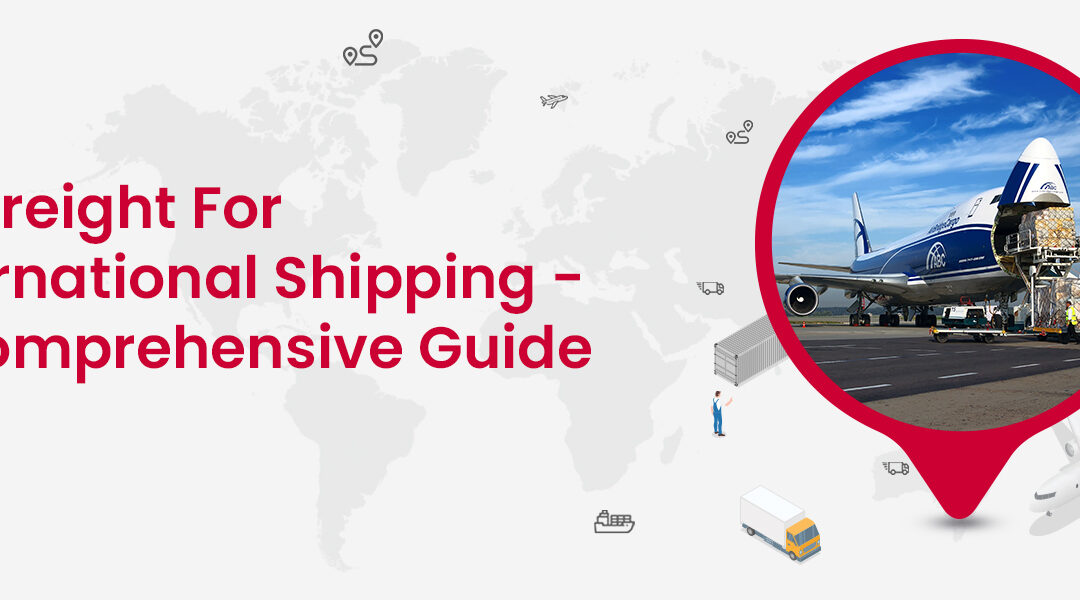Delivery by air has always been an essential component of logistics and global trade. It always seems fascinating that a vehicle flying 1000 miles up off the ground can lift much weight, literally everything. The consistent advancement in aviation technology has made international cargo shipment so easy. This also helped eCommerce businesses to sell globally. Through air freight cargo, eCommerce sellers can sell everything from clothing and toys to electronics and more to customers from other countries.
This blog presents a comprehensive guide to air freight for international shipping that will help eCommerce businesses.
Air Freight Costs and International and Express Air Freight Rates Per kg
Air cargo is a popular option for eCommerce businesses that must transport goods quickly and reliably globally. While ocean freight is the most commonly used method for shipping goods, accounting for 90% of all shipped goods, air cargo offers faster transit times, with the ability to cut shipping time from China to the US from 20-30 days by the ocean to just three days by air.
International and express air freight are two distinct types of air cargo services.
Express Air Freight
One company, such as DHL, UPS, or FedEx, typically handles it and offers door-to-door service within five days. These shipments are usually smaller, with a maximum weight of 200 kilograms and a volume of less than one cubic meter.
International Air Freight
Shipments can be larger and may be handled by multiple carriers during transit.
International air cargo rates can vary depending on the type of cargo being shipped, the available space, and the demand. In a typical season, the cost can range from $2.50 to $5.00 per kilogram. However, due to disruptions in ocean freight and increased consumer demand, air cargo rates have risen significantly since February 2020. Currently, they range from $4.00 to $8.00 per kilogram.
It’s important to note that air cargo shipping costs depend on many factors, including the cargo’s size, weight, value, routing, transit time, handling, security, storage, and customs clearance. Therefore, it’s advisable to work with a freight forwarder to get a comprehensive quote for your shipment. They can provide you with the best possible rates and services.
How is Air Freight Shipped?
Registration and Pickup
This is the stage where the shipper, typically an eCommerce business owner, coordinates with the air carrier or freight forwarder to schedule the cargo pickup:
- The shipper must have all necessary documentation and permits in order.
- Once all the required documentation is in order, the shipper must coordinate with the air carrier or freight forwarder to schedule a pickup date and time for the cargo. This can typically be done via phone or email.
- The shipper must provide the carrier with all relevant details about the cargo, such as its location, packaging, and special handling requirements.
Confirmation and Labeling
Before the cargo is loaded onto the aircraft, the air carrier or freight forwarder will verify the shipment details. This includes checking that the cargo is properly packaged and secured and ensuring that all necessary documentation and permits are in order. Then the carrier will ensure that the cargo is adequately packaged to protect it from damage during transit and that it is appropriately labelled with the required information, such as the shipper’s contact information, the intended destination, and any special handling instructions.
Customs Clearance at The Airport of Origin
Once the cargo has been confirmed, labelled, and packaged, it moves on to the next stage of the air freight process: customs clearance at the airport of origin. Before the cargo can be loaded, it must go through the customs clearance process at the origin airport. This involves completing necessary customs paperwork and declarations. Once all of the required paperwork and declarations have been completed, customs officials will inspect the cargo to ensure that it complies with all necessary regulations. Finally, customs officials will issue clearance for the cargo to depart if everything is in order.
Stowage and Departure
After the cargo has been cleared for export and prepared for stowage, it will be loaded onto the aircraft. This typically involves using specialized equipment, such as cargo loaders and dollies, to move the cargo from the loading area to the aircraft’s cargo hold. After the cargo has been loaded onto the aircraft, it will be properly secured in the cargo hold to ensure it remains in place during transit. Once the cargo has been loaded and secured, the aircraft will depart from the airport of origin.
Unloading of Cargo
Upon arrival at the destination airport, the aircraft will be directed to a designated cargo unloading area. The cargo will be offloaded from the aircraft by specialized cargo handling equipment. Then the cargo will be inspected to ensure that it is in good condition and matches the information provided on the bill of lading and other shipping documentation.
Customs Clearance at The Destination Airport
Once the cargo has been offloaded and inspected at the destination airport, it must first go through the customs clearance process at the destination airport. This involves completing necessary customs paperwork and declarations, such as an import declaration, a bill of lading, and any required import licenses or permits. Once all of the required paperwork and declarations have been completed, customs officials will inspect the cargo to ensure that it complies with all necessary regulations in the destination country.
Delivery
Before the cargo can be delivered, the air carrier or the freight forwarder will need to coordinate with the receiving party to ensure that they know the cargo’s arrival and can make arrangements to pick it up. After that, the cargo will be transported to its final destination. This typically involves using a combination of ground transportation and delivery services, such as trucks, vans, or delivery bikes.
What Is Considered Air Freight?
Express Air Freight
Express air freight is a service that prioritizes speed and efficiency over cost. It is typically used to transport high-value, time-sensitive, or perishable goods that require a fast delivery time. One of the main features of express air freight is its speed. It typically guarantees delivery within a specific timeframe, often 24 hours or less. This makes it a suitable option for goods with short shelf life or that are needed urgently.
Charter Air Freight
Charter air freight is a type of air freight service that allows customers to rent an entire aircraft to transport their cargo. This contrasts traditional air freight services, where cargo is consolidated with other shipments and transported on scheduled flights.
Customers can choose the specific aircraft and route that best suits their cargo, which allows them to optimize transit times and minimize handling.
Consolidated Air Freight
Consolidated air freight is a type of air freight service where cargo from multiple shippers is consolidated into a single shipment and transported on scheduled flights. This allows shippers to benefit from lower costs and increased efficiency, as they can share the cost of the flight with other shippers.
By consolidating cargo from multiple shippers, the cost per unit of cargo is reduced, making it a more affordable option for eCommerce businesses that don’t require the speed or exclusivity of express or charter air freight services.
Commercial Airline
Commercial airlines are primarily focused on transporting passengers and their baggage but also offer air freight services as a secondary source of revenue. These airlines offer air freight services by dedicating a portion of the cargo hold on their passenger flights to freight transportation. This is known as “belly cargo” or “passenger-freight combination” service.
Cargo Airline
Cargo airlines, also known as freighters, are airlines that specialize in the transportation of cargo. They operate flights specifically designed to transport cargo. Their aircraft are outfitted with larger cargo holds and are more suitable for freight than commercial airlines. Cargo airlines typically operate a global network of routes and destinations and have specialized equipment and facilities for handling and transporting cargo. Examples of cargo airlines are FedEx, UPS, and DHL.
How Much Does It Cost to Air Freight?
The cost of air freight shipping can vary greatly depending on several factors, such as the weight and size of the item, the distance it is being shipped, the speed at which it needs to be delivered, and the type of cargo. As a result, air freight can be more expensive than shipping by ground or sea, but it is also faster.
Air freight prices range from $1.50 to $4.50 per kilogram. The cost of air freight can limit its demand, as it is typically 4-5 times more expensive than road transport and 12-16 times more expensive than sea transport. Despite the higher cost, the value of air cargo usually exceeds $4.00 per kilogram. At Indian airports, the handling rates for general cargo range from 74 paise to Rs 2.22 per kilogram. Special cargo handling rates range from Rs 1.47 to Rs 6 per kilogram.
How To Calculate Air Freight Cost?
Calculating the cost of air freight can be a bit complex, as it depends on several factors. However, here is a general process for calculating air freight costs:
Determine The Weight And Volume Of Your Cargo
The weight and volume of your cargo will determine the amount of space it takes up on the plane, affecting the shipping cost. The weight is measured in kilograms (kg), and the volume is measured in cubic meters (m³).
Choose The Destination
The destination of your cargo also affects the cost of shipping. For example, the cost of shipping to a nearby country will be less than shipping to a country that is farther away.
Choose The Level Of Service Required
Air freight shipping can be divided into three categories: economy, priority, and express. Economy air freight is the most affordable option, but it may take longer for the package to reach its destination. Priority air freight is a bit more expensive, but it will get the package to its destination faster. Finally, express air freight is the most costly option but is the fastest and most reliable.
Contact The Air Freight Company
It is best to contact a reputable air freight shipping company and provide all the necessary information about your shipment, including weight, volume, destination, level of service required, and any additional services needed. The company will then give you a quote for the cost of shipping.
It is important to note that there are different air freight rate structures, such as general cargo rates, special cargo rates, oversized cargo rates, and more. In addition, the direct or indirect flight type will also affect the cost, as a direct flight will be more expensive than an indirect one.
To determine the volumetric weight of an item for air shipping, you can use the formula: volumetric weight = volume (in cubic meters) x 167. For example, if a package has a width of 40cm, a height of 40cm, and a length of 40cm, the volume would be .064 cubic meters (width x height x length divided by one million). Multiplying this by 167 would give a volumetric weight of 10.67 kg. Suppose the volumetric weight exceeds the actual weight of the item. In that case, the volumetric weight will be the chargeable weight. You can use a chargeable weight calculator to determine if your shipment will be charged based on its actual or volumetric weight, particularly for lightweight air shipments.
Air Freight Shipping Prices And Costs
The Benefits Of Air Freight
Fastest Shipping Method
Air freight is the fastest mode of transportation for goods, making it ideal for time-sensitive or perishable items. It can take as little as 24 hours to transport goods from one location to another, compared to several days or weeks for sea or ground transportation.
Reliability
Air freight companies have strict schedules and operate with a high level of precision, which means that goods are less likely to be delayed or lost in transit.
Security
Air freight companies have strict security measures to protect goods in transit. They are also able to handle special requirements like temperature-controlled cargo, hazardous materials, and live animals.
Low Insurance Premium
Since the goods are in transit for a shorter period, you have to pay fewer insurance premiums. While the actual price of the air freight might be high, eCommerce businesses can save money in other areas, like low insurance costs. This can also be a cost-saving measure for businesses, as they can save money on insurance costs without compromising on the security and safety of their goods. Additionally, air freight companies often have strict security protocols and procedures to protect goods during transit which can further minimize the risk of loss or damage.
When Shouldn’t I Ship By Air?
Cost
Air freight is generally more expensive than other forms of transportation, such as sea or ground shipping. If cost is a major concern and the goods are not time-sensitive, it may be more cost-effective to ship by sea or ground. It’s important to weigh the cost of air freight against the value of the goods being shipped and the time sensitivity of the shipment.
Quantity of Goods
Air freight is better suited for smaller quantities of goods, as the cost per unit can be high for large shipments. However, sea or ground shipping may be more cost-effective if you have many goods to transport. Therefore, it’s important to consider the weight and volume of the goods being shipped and compare it with the cost of air freight versus sea or ground shipping.
Destination
Airfreight is not always available to all destinations, and some remote areas can only be reached by sea or ground. Therefore, it’s important to check with the air freight company to see if they offer service to the destination you are shipping to. If not, explore alternative shipping options.
Lead Time
Airfreight is a faster mode of transportation, but if the lead time is not critical, shipping by sea or ground is a more cost-effective option. Therefore, it’s important to assess the urgency of the shipment and compare the lead time of air freight versus sea or ground shipping to make an informed decision.
What Goods Are Generally Shipped Via Air Freight?
High-Value Or Time-Sensitive Goods
Air freight is well-suited for expensive or time-sensitive goods, such as electronics, medical equipment, and machinery. These goods are often needed quickly and have a high value, making air freight the best option for getting them to market quickly and safely. Air freight is also a good option for goods that are unique, one-of-a-kind, or hard to replace.
Perishable Goods
Air freight is also commonly used to transport perishable goods such as fruits, vegetables, flowers, and seafood. These goods must be transported quickly to avoid spoilage, and air freight allows them to reach their destination quickly and in good condition. This type of cargo usually requires special handling and packaging, such as temperature-controlled containers, to keep the goods fresh during transport.
Fashion And Luxury Goods
Air freight is also commonly used to transport high-end fashion and luxury goods, such as designer clothing and jewellery. These goods are often in high demand and must be delivered quickly to meet customers’ needs. They also require special handling and packaging to ensure they reach the destination in perfect condition.
Pharmaceuticals And Medical Supplies
Air freight is also commonly used to transport pharmaceuticals and medical supplies, as they need to be kept at a specific temperature and need to reach their destination quickly and reliably. In addition, these goods require special handling, packaging, and documentation to ensure they meet regulatory requirements and are transported safely and efficiently.
Heavy And Bulky Goods
Air freight is the only option for heavy and bulky goods, as they are not suitable for sea or ground shipping due to weight and size restrictions. Examples of heavy and bulky goods include construction equipment, mining machinery, and industrial generators. These goods require special handling and transportation arrangements; usually, only freight planes can accommodate them.
Air Freight Shipping Rates & Charges
In addition to the base cost of air freight, the overall cost of shipping by air will also include additional charges, such as:
- Fuel surcharges
- Security surcharges
- Container freight station/terminal handling charges
- Airport transfer
For door-to-door shipments, the cost will also include the following charges:
- Customs Brokerage
- Pickup and delivery
- Cargo insurance
- Accessorial charges
Are International Air Freight Quotes And Air Freight Prices Changing?
International air freight prices and quotes can change due to various factors, such as fuel prices, demand, and capacity. These prices can fluctuate daily, weekly, or monthly. However,
In recent times air freight usage has taken a hit. The International Air Transport Association (IATA) said that air freight growth only hit 1.6% in 2019, down from 5% in 2014. One reason for this was increased reliance on ocean freight.
According to Transport Intelligence, International air freight usage was growing slowly, with less than 1% growth in 2015 among the world’s top freight forwarders. Also, since March 2020, air cargo rates have doubled due to constrained capacity, limited passenger travel due to restrictions, increased consumer demand, and other factors resulting from the pandemic. On the other hand, air passenger travel is stabilized, freeing up more belly cargo space. However, prices are still very high, with importers and exporters often sticking with ocean freight if they can afford the time. Most companies importing or exporting goods internationally still do everything they can to take advantage of cheaper ocean freight quotes, leaving only the most urgent shipments for air.




